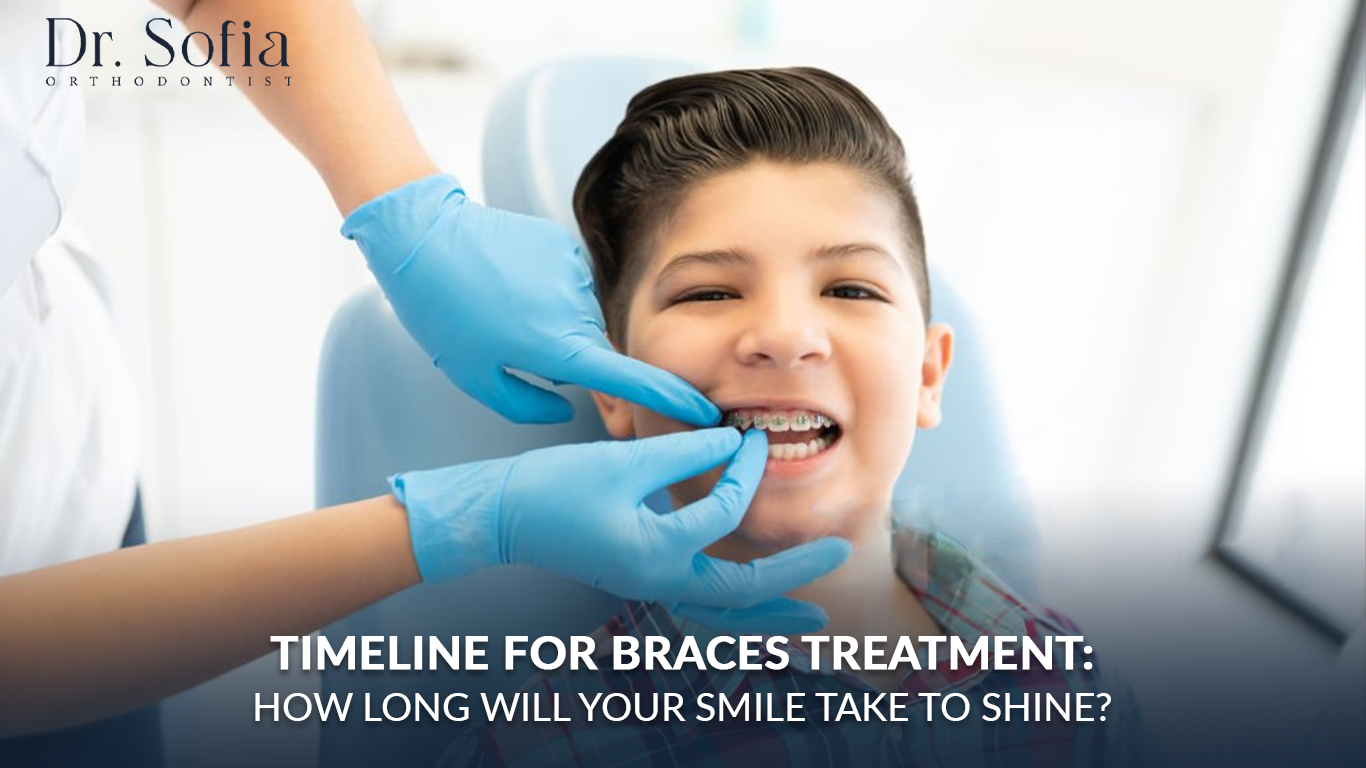


The first question that comes to our mind is: “How long will the braces treatment take?”
Several factors that can affect how long the duration of braces lasts, includes the patient’s age, the severity of dental malalignment, and the specifics of the treatment plan devised by your orthodontist.
Orthodontic treatments start with the right timing and planning. Whether you are a teenager with an ongoing jaw growth process or an adult trying to have better alignment, this blog will assist you in understanding the timeframe.
If you are one of the residents of Kolkata who want world-class care, Dr. Sofia Hawelia is the best orthodontist in Kolkata who provides customized and also effective braces treatment.
Several factors determine the duration of your braces treatment.
Let’s explore some of the most significant ones:
Younger patients often see quicker results because their jawbones are still growing and more responsive to correction. This process makes braces treatment more effective in kids and teens. The procedure has no upper age limit, although adults may take a little longer to find their best results because their bone structures are less malleable.
The complexity of dental malalignment significantly affects how long treatment will take.
For mild cases, such as small gaps or slight malalignments, treatment may only last a few months. However, moderate to severe cases, which include issues like crowding, overbites, and underbites, usually need a longer duration, typically between 12 to 24 months. The more intricate the malalignment, the longer it will take to create a balanced and symmetrical smile.
A personalized treatment plan is essential. In some of these cases, extractions are involved in creating the space needed, which can extend the timeline while in other cases the problem can be solved with a non-extraction method. Surgery will be followed while innovative techniques will also Your orthodontist ultimately is still the one that is responsible for what strategies are used and that ultimately tends to dictate the overall time that braces treatment would take.
Cooperation from the patient is crucial for successful braces treatment.
This includes:
If any of these aspects are overlooked, it can lead to delays, necessitating extra adjustments and extending the overall treatment time.
Although braces treatment duration is quite specific to each individual, orthodontists often divide treatment times into general categories:
For patients with relatively minor dental issues, such as small gaps or simple malalignments, the treatment can take place in 10 to 12 months. This length of time is typical in situations where:
A shorter treatment period doesn’t mean the results are less impressive; it simply points to the fact that less complicated issues can be addressed more efficiently.
Most orthodontic cases are of this type. Most patients should plan to wear braces for approximately 12 to 18 months. A time frame as such would enable the correcting of more common problems including moderate crowding or malalignment. If extractions are required to create sufficient space, the treatment will tend toward the higher end of this range. For many, this is the “sweet spot” where practical dental corrections can be made without a lengthy treatment time.
In the case of more complex issues, such as moderate-to-severe dental irregularities, treatment may take anywhere between 18 and 24 months. These cases often include:
Growth modulating treatments are performed in the growing years of a child where the phasing of growth of the jaws are modulated to get the desired results. The patient’s drug is used during the entire growing stage and thus, these treatments show a longer duration of treatment.
The 1st phase of the therapy is then followed by a 2nd phase and correction is done by the dentist. The model described above becomes a two-phase process that is often needed to ensure the advantages of early intervention are maximized, resulting in a more successful treatment for patients in the longer term.

After the active phase of braces treatment, the journey does not stop there.
This retention phase is important to keep those results you will obtain through treatment. This phase can vary in length, depending on the complexity of the original problem and the type of retainer you were prescribed.
Regular and proper use of the retainer will help in keeping your teeth in the positions they have been placed according to the braces treatment and not find their way back to their original state or position.
Each smile is unique, and as such, so are the braces needed to perfect it. If you jump straight into treatment without a full understanding of what is going on you can end up not getting the best outcome or taking longer to resolve your symptoms. However, the following information may help you to understand the process better, since a detailed consultation with an orthodontist is the key to:
If you’re in Kolkata and looking for top-notch orthodontic braces, Dr. Sofia Hawelia provides tailored and cutting-edge treatments. With extensive experience, she guarantees that even the most challenging cases are handled effectively and efficiently.
Knowing the timeline of your braces treatment is critical in helping you set realistic expectations for your journey to a healthier smile. Whether your case is simple or complicated, you are going to need a carefully considered treatment plan developed with a qualified orthodontist.
The length of treatment is determined by age, the extent of the malalignment, the complexity of the treatment plan, and most importantly, patient motivation and compliance.
Orthodontics care is not just about achieving straight teeth; it’s all about achieving a balanced, functional, and beautiful smile that improves your overall oral health and boosts your confidence. The retainer phase is important because it helps keep your new smile stable for years to come.
For individualized orthodontic treatment in Kolkata, consult Dr. Sofia Hawelia, the best orthodontist in kolkata. With cutting-edge technology and a wealth of experience, her patients achieve beautiful braces treatment outcomes.
Note: The duration of treatment will be unique to you; schedule a detailed check-up to know more.
Book your consultation today!
Age plays a major role in the timing of braces treatment. This is due to active bone growth in younger patients, which allows for quicker tooth movement and thus, shorter treatment time. Contrast that with adult bone, which is relatively unresponsive, needing more time to make changes. But with expert orthodontic treatment, a smile can be obtained at any age.
The bi-phasic treatment involves two separate orthodontic treatments to give the best possible growth modifications to a growing child. The first stage helps encourage jaw development early on for spacing for appropriate tooth placement. The second stage, once permanent teeth come in, is about fine-tuning alignment. This technique helps avoid complicated conditions and minimize the need for extractions or surgery.
When braces are put on, some people feel mild pain and soreness in the teeth and gums, mouth ulcers, difficulty eating certain foods, and temporary changes in speech. Some patients also experience irritation from brackets and wires, increased sensitivity, or minor jaw soreness while adjustments shift teeth into their new positions.
